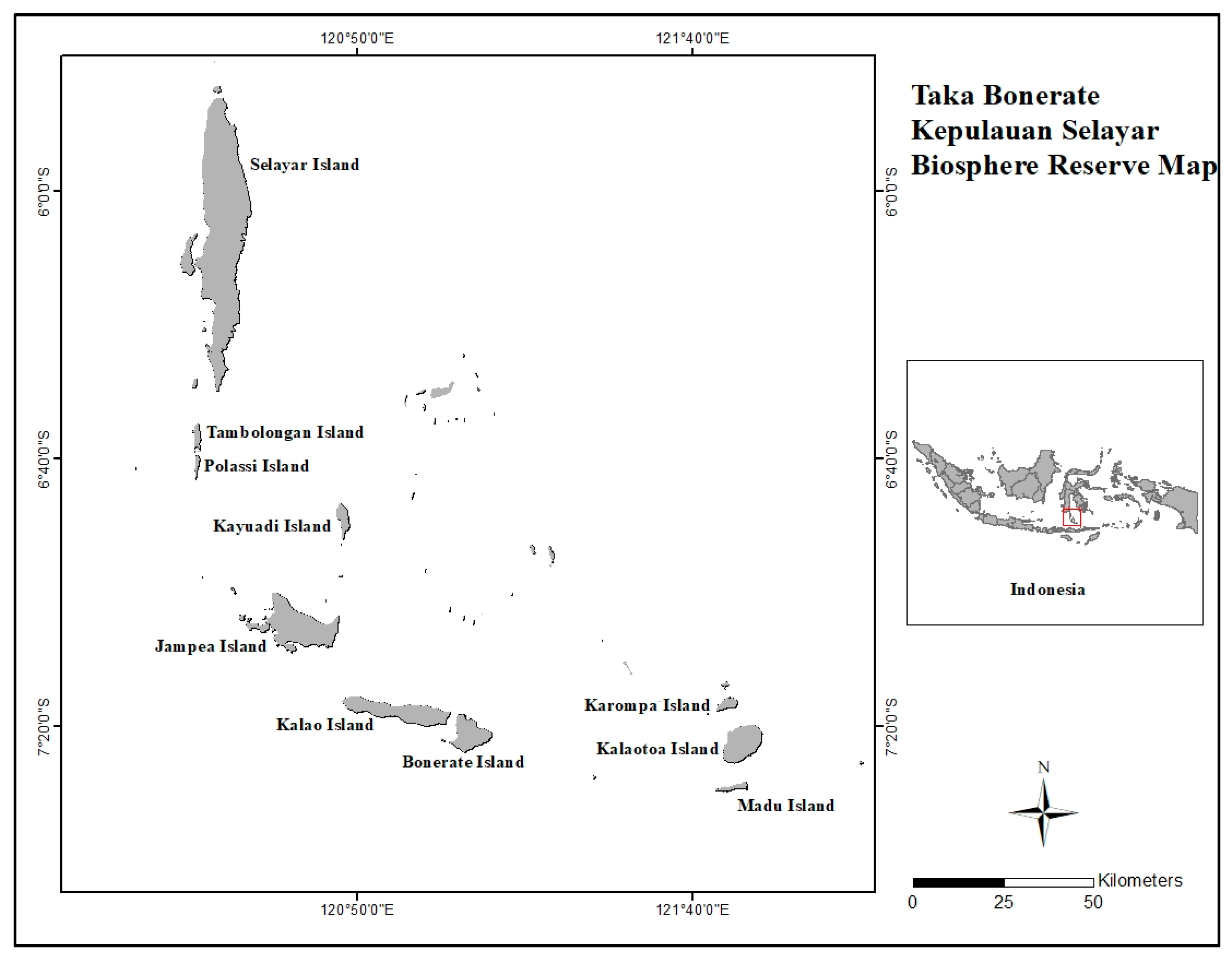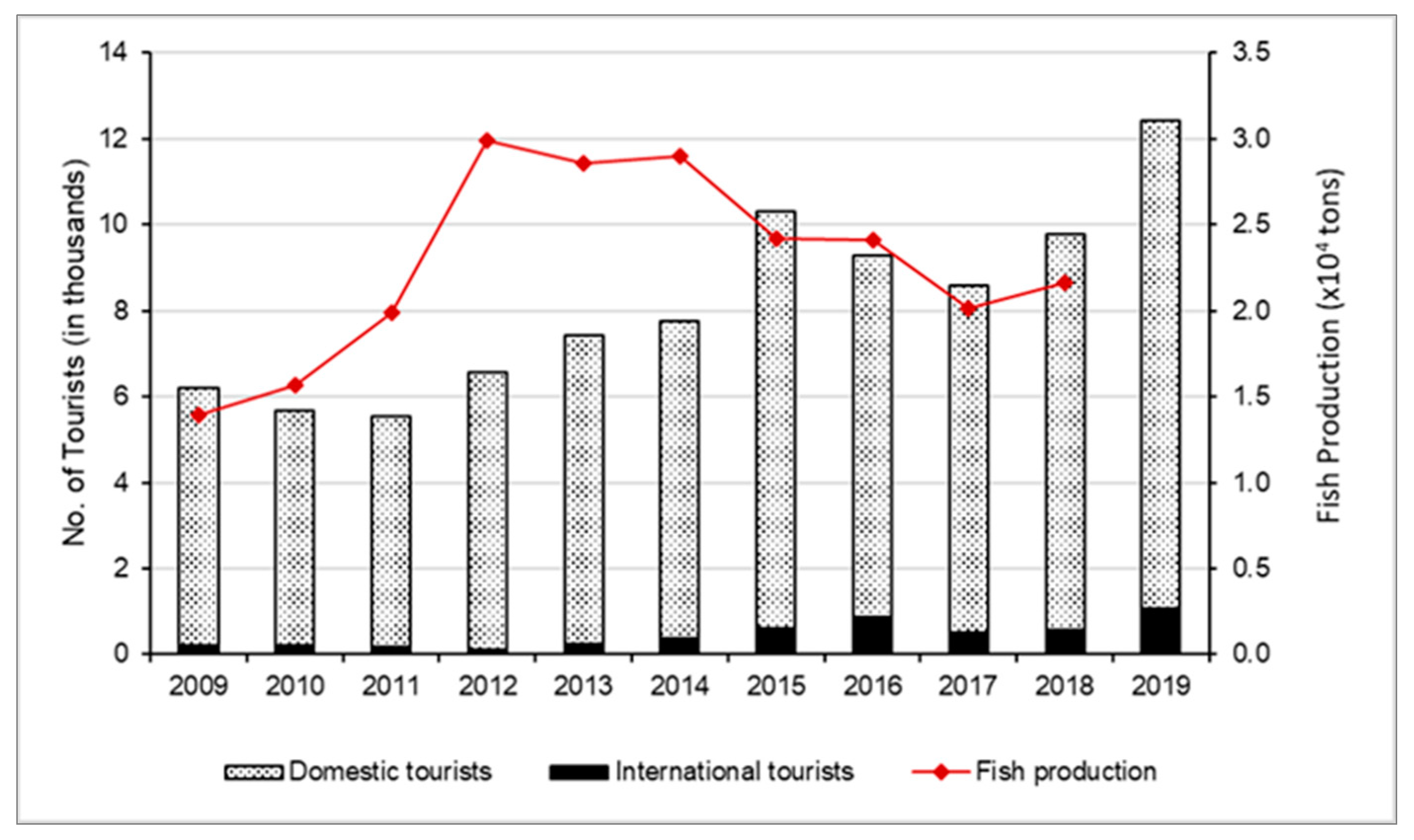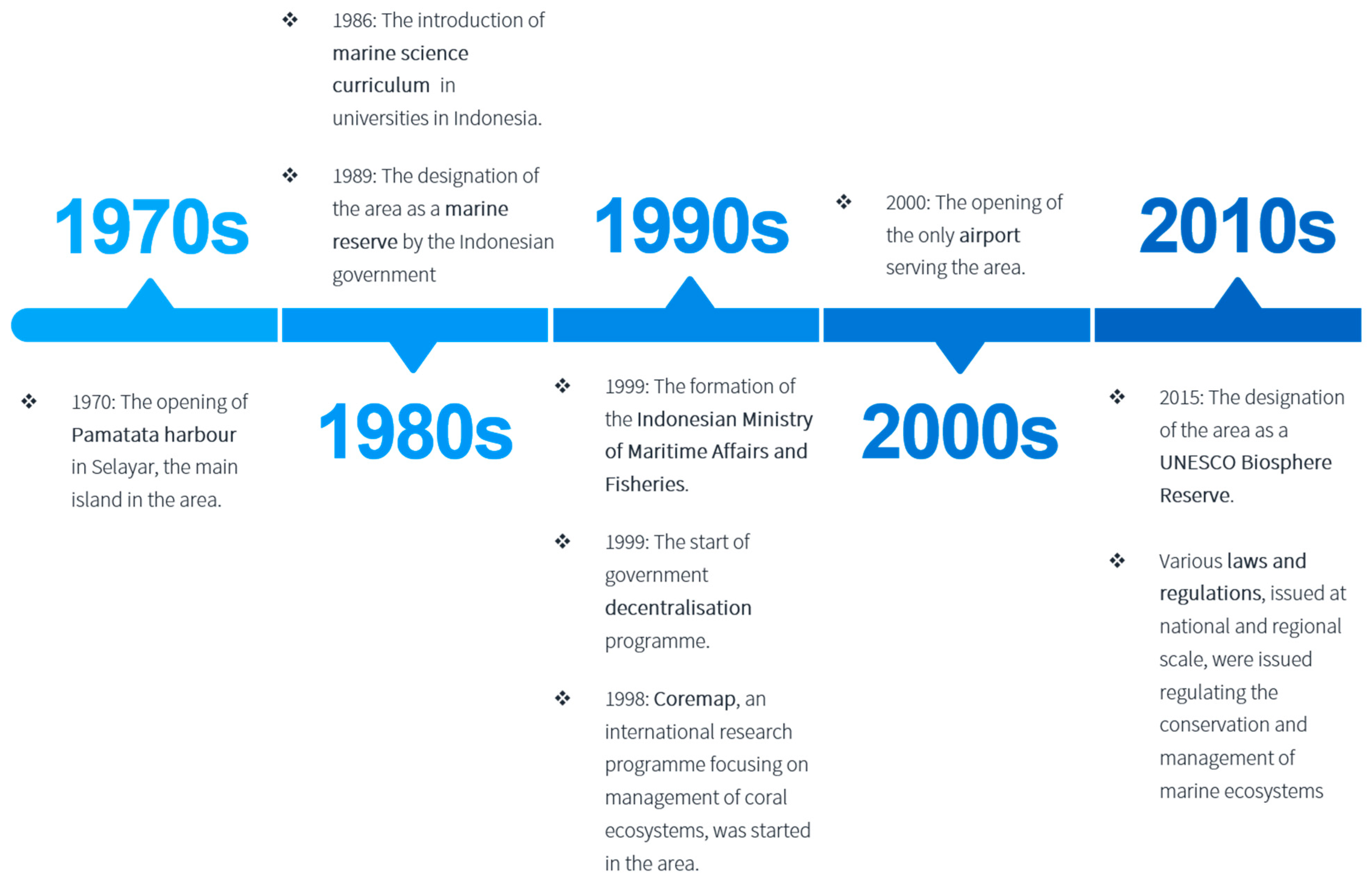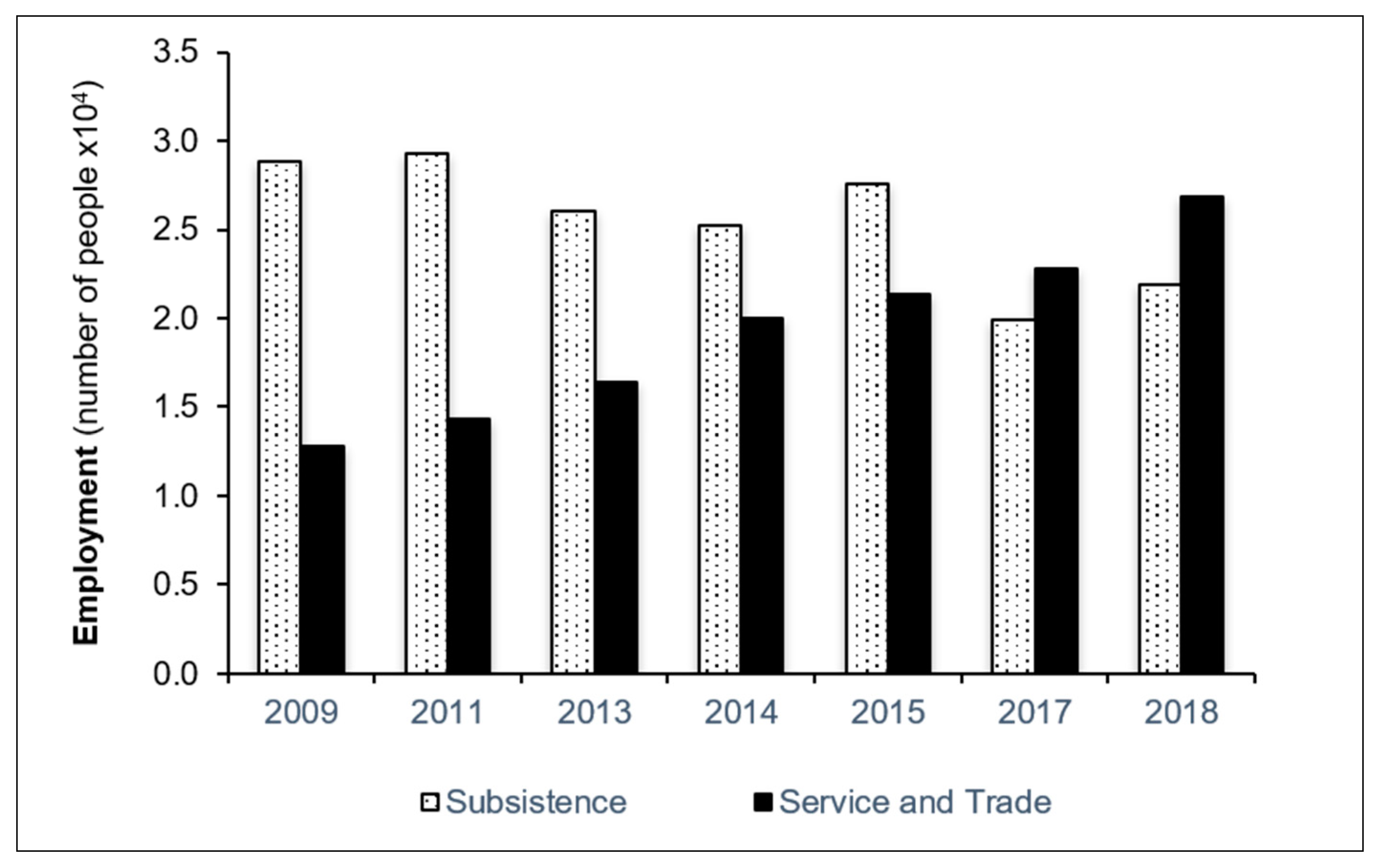Tourism-Based Alternative Livelihoods for Small Island Communities Transitioning towards a Blue Economy
Abstract
1. Introduction
2. Study Site
3. Method
4. Results
4.1. History of Livelihood Changes in TBKS
4.2. Drivers to the Development of Tourism-Based Alternative Livelihoods
“In some islands, the solar panels installed there have enabled local communities to divert towards more diverse economic activities, especially during the night time, so they can, for instance, open kiosks with attractive displays”.
“Several guest houses and resorts developed by rich people—both Indonesians and foreigners. Some of the resorts are the most influential—want tourists to come so they protect their areas and stop fishermen coming into the transition zone (informally)”.(Participant, FGD 5)
4.3. Barriers to the Development of Tourism-Based Alternative Livelihoods
“Tourism sector in the islands depends very much on the service provided by the transportation sector to ensure the efficiency of the time used by tourist to enter into the area. However, so far, many airlines seem to be reluctant to provide competitive ticket pricing and free luggage service that deters many tourists to enter small islands”.
“My decision to work as a fisherman was driven by the inability of my family to fund higher education. However, if given the chance to study or work in another profession, such as resort worker or nurse, I would have taken it instead of fishing. I think the same conditions also happens with my peers in this village”.
5. Discussion and Conclusions
Research Ethics Statement
Author Contributions
Funding
Institutional Review Board Statement
Informed Consent Statement
Data Availability Statement
Acknowledgments
Conflicts of Interest
References
- Brandon, K.E.; Wells, M. Planning for people and parks: Design dilemmas. World Dev. 1992, 20, 557–570. [Google Scholar] [CrossRef]
- Stronza, A.L.; Hunt, C.A.; Fitzgerald, L.A. Ecotourism for Conservation? Annu. Rev. Environ. Resour. 2019, 44, 229–253. [Google Scholar] [CrossRef]
- Walpole, M.J.; Thouless, C.R. Increasing the value of wildlife through non-consumptive use? Deconstructing the myths of ecotourism and community-based tourism in the tropics. Conserv. Biol. Ser. 2005, 9, 122. [Google Scholar]
- Goodwin, H.; Roe, D. Tourism, livelihoods and protected areas: Opportunities for fair-trade tourism in and around National parks. Int. J. Tour. Res. 2001, 3, 377–391. [Google Scholar] [CrossRef]
- OECD (Organisation for Economic Co-operation and Development). The Ocean Economy in 2030; OECD: Paris, France, 2016. [Google Scholar]
- Golden, J.S.; Virdin, J.; Nowacek, D.; Halpin, P.; Bennear, L.; Patil, P.G. Making sure the blue economy is green. Nat. Ecol. Evol. 2017, 1, 17. [Google Scholar] [CrossRef] [PubMed]
- Cisneros-Montemayor, A.M.; Moreno-Báez, M.; Reygondeau, G.; Cheung, W.W.L.; Crosman, K.M.; González-Espinosa, P.C.; Lam, V.W.Y.; Oyinlola, M.A.; Singh, G.G.; Swartz, W.; et al. Enabling conditions for an equitable and sustainable blue economy. Nature 2021, 591, 396–401. [Google Scholar] [CrossRef] [PubMed]
- Buckley, R. Tourism and Environment. Annu. Rev. Environ. Resour. 2011, 36, 397–416. [Google Scholar] [CrossRef]
- Holden, A. Environment and Tourism; Routledge: London, UK, 2016. [Google Scholar]
- Ellis, F. Rural Livelihood Diversity in Developing Countries: Evidence and Policy Implications; Overseas Development Institute: London, UK, 1999; Volume 40. [Google Scholar]
- Nyaupane, G.P.; Poudel, S. Linkages among biodiversity, livelihood, and tourism. Ann. Tour. Res. 2011, 38, 1344–1366. [Google Scholar] [CrossRef]
- Yadav, N.; Sahu, N.C.; Sahoo, D.; Yadav, D.K. Analysis of barriers to sustainable tourism management in a protected area. Benchmarking Int. J. 2018, 25, 1956–1976. [Google Scholar] [CrossRef]
- Summers, J.; Cavaye, J.; Woolcock, G. Enablers and Barriers of Tourism as a Driver of Economic and Social-cultural Growth in Remote Queensland. Econ. Pap. A J. Appl. Econ. Policy 2019, 38, 77–94. [Google Scholar] [CrossRef]
- Coulthard, S.; Evans, L.; Turner, R.; Mills, D.; Foale, S.; Abernethy, K.; Hicks, C.; Monnereau, I. Exploring ‘islandness’ and the impacts of nature conservation through the lens of wellbeing. Environ. Conserv. 2017, 44, 298–309. [Google Scholar] [CrossRef]
- UNEP (UN Environment Programme). GEO Small Island Developing States Outlook; United Nations Environment Programme: Nairobi, Kenya, 2014. [Google Scholar]
- Connell, J. Islands at Risk?: Environments, Economies and Contemporary Change; Edward Elgar Publishing: Cheltenham, UK, 2013; ISBN 1-78100-351-3. [Google Scholar]
- Turvey, R. Vulnerability assessment of developing countries: The case of small-island developing States. Dev. Policy Rev. 2007, 25, 243–264. [Google Scholar] [CrossRef]
- Kurniawan, F.; Adrianto, L.; Bengen, D.G.; Prasetyo, L.B. Vulnerability assessment of small islands to tourism: The case of the Marine Tourism Park of the Gili Matra Islands, Indonesia. Glob. Ecol. Conserv. 2016, 6, 308–326. [Google Scholar] [CrossRef]
- Purwanto, Y. Jusman Taka Bonerate-Selayar Biosphere Reserve Management Plan; The Indonesian MAB Programme National Committee: Bogor, Indonesia, 2014. [Google Scholar]
- UNESCO (United Nations Educational, Scientific and Cultural Organization). Biosphere Reserve. Available online: https://en.unesco.org/biosphere (accessed on 7 June 2020).
- UNESCO (United Nations Educational, Scientific and Cultural Organization). Taka Bonerate-Kepulauan Selayar. Available online: http://www.unesco.org/new/en/natural-sciences/environment/ecological-sciences/biosphere-reserves/asia-and-the-pacific/indonesia/taka-bonerate-kepulauan-selayar (accessed on 8 April 2021).
- Lampe, M. Coral Reef Fisheries Resource Management in Taka Bonerate National Park Based on Constructionism Perspective BT. In Proceedings of the Unhas International Conference on Social and Political Science (UICoSP 2017); Atlantis Press: Paris, France, 2017; pp. 41–45. [Google Scholar] [CrossRef][Green Version]
- Kleiner, A.; Roth, G. Field Manual for a Learning Historian. 1996. Available online: https://solonline.org/wp-content/uploads/2016/12/Field-Manual-Master.pdf (accessed on 12 April 2021).
- Fortnam, M.; Chaigneau, T.; Evans, L. Participatory Marine Governance Analysis (PMGA): Facilitation Manual; GCRF Blue Communities Programme: Exeter, UK, 2018. [Google Scholar]
- Deterding, N.M.; Waters, M.C. Flexible coding of in-depth interviews: A twenty-first-century approach. Sociol. Methods Res. 2018, 50, 708–739. [Google Scholar] [CrossRef]
- Badan Pusat Statistik Selayar. Kabupaten Kepulauan Selayar Dalam Angka 2015. 2015. Available online: https://selayarkab.bps.go.id/publication/2015/12/07/df3131e695caa49017eece64/kabupaten-kepulauan-selayar-dalam-angka-2015.html (accessed on 25 April 2020).
- Badan Pusat Statistik Selayar. Kabupaten Kepulauan Selayar Dalam Angka 2016. 2016. Available online: https://selayarkab.bps.go.id/publication/2016/07/15/31fcec45b19fa7eb44bb4dab/kabupaten-selayar-dalam-angka-2016.html (accessed on 25 April 2020).
- Badan Pusat Statistik Selayar. Kepulauan Selayar Dalam Angka 2014. 2014. Available online: https://selayarkab.bps.go.id/publication/2015/04/28/1b8b9b2be31e7d2fc317da72/kepulauan-selayar-dalam-angka-2014.html (accessed on 25 April 2020).
- Badan Pusat Statistik Selayar. Kabupaten Kepulauan Selayar Dalam Angka 2018. 2018. Available online: https://selayarkab.bps.go.id/publication/2018/08/16/073e1ff17d7be50dcb123675/kabupaten-kepulauan-selayar-dalam-angka-2018.html (accessed on 25 April 2020).
- Badan Pusat Statistik Selayar. Kabupaten Kepulauan Selayar Dalam Angka 2019. 2019. Available online: https://selayarkab.bps.go.id/publication/2019/08/16/fcd558bb2568bacc690cd6db/kabupaten-kepulauan-selayar-dalam-angka-2019.html (accessed on 25 April 2020).
- Selayar Office for Tourism. Data on Tourist Visit in Kabupaten Kepulauan Selayar in 2015–2020 (In Indonesia); Dinas Kebudayaan dan Pariwisata: Benteng, Indonesia, 2020.
- Bennett, N.J.; Dearden, P. Why local people do not support conservation: Community perceptions of marine protected area livelihood impacts, governance and management in Thailand. Mar. Policy 2014, 44, 107–116. [Google Scholar] [CrossRef]
- Cinner, J.E.; Daw, T.; Huchery, C.; Thoya, P.; Wamukota, A.; Cedras, M.; Abunge, C. Winners and Losers in Marine Conservation: Fishers’ Displacement and Livelihood Benefits from Marine Reserves. Soc. Nat. Resour. 2014, 27, 994–1005. [Google Scholar] [CrossRef]
- Agrawal, A.; Gupta, K. Decentralization and Participation: The Governance of Common Pool Resources in Nepal’s Terai. World Dev. 2005, 33, 1101–1114. [Google Scholar] [CrossRef]
- Wong, S. Elite Capture or Capture Elites? Lessons from the ’Counter-Elite’ and ’Co-Opt-Elite’ Approaches in Bangladesh and Ghana; WIDER Working Paper 2010/082; UNU WIDER: Helsinski, Finland, 2010. [Google Scholar]
- Muchapondwa, E.; Stage, J. Whereto with institutions and governance challenges in African wildlife conservation? Environ. Res. Lett. 2015, 10, 95013. [Google Scholar] [CrossRef]
- Pinkerton, E.; Edwards, D.N. The elephant in the room: The hidden costs of leasing individual transferable fishing quotas. Mar. Policy 2009, 33, 707–713. [Google Scholar] [CrossRef]
- Carothers, C.; Chambers, C. Fisheries privatization and the remaking of fishery systems. Environ. Soc. 2012, 3, 39–59. [Google Scholar] [CrossRef]
- Haas, A.R.; Edwards, D.N.; Sumaila, U.R. Corporate concentration and processor control: Insights from the salmon and herring fisheries in British Columbia. Mar. Policy 2016, 68, 83–90. [Google Scholar] [CrossRef]
- Chaigneau, T.; Brown, K. Challenging the win-win discourse on conservation and development: Analyzing support for marine protected areas. Ecol. Soc. 2016, 21, 36. [Google Scholar] [CrossRef]
- Hamann, M.; Berry, K.; Chaigneau, T.; Curry, T.; Heilmayr, R.; Henriksson, P.J.; Hentati-Sundberg, J.; Jina, A.; Lindkvist, E.; Lopez-Maldonado, Y. Inequality and the Biosphere. Annu. Rev. Environ. Resour. 2018, 43, 61–83. [Google Scholar] [CrossRef]
- Fortnam, M.; Brown, K.; Chaigneau, T.; Crona, B.; Daw, T.M.; Gonçalves, D.; Hicks, C.; Revmatas, M.; Sandbrook, C.; Schulte-Herbruggen, B. The gendered nature of ecosystem services. Ecol. Econ. 2019, 159, 312–325. [Google Scholar] [CrossRef]
- Chaigneau, T.; Coulthard, S.; Brown, K.; Daw, T.M.; Schulte-Herbrüggen, B. Incorporating basic needs to reconcile poverty and ecosystem services. Conserv. Biol. 2019, 33, 655–664. [Google Scholar] [CrossRef]
- Kaimowitz, D.; Sheil, D. Conserving what and for whom? Why conservation should help meet basic human needs in the tropics. Biotropica 2007, 39, 567–574. [Google Scholar] [CrossRef]
- CINNER, J.E.; Daw, T.; McCLANAHAN, T.R. Socioeconomic factors that affect artisanal fishers’ readiness to exit a declining fishery. Conserv. Biol. 2009, 23, 124–130. [Google Scholar] [CrossRef]
- Chiutsi, S.; Saarinen, J. Local participation in transfrontier tourism: Case of Sengwe community in great Limpopo transfrontier conservation area, Zimbabwe. Dev. S. Afr. 2017, 34, 260–275. [Google Scholar] [CrossRef]
- Mbaiwa, J.E. The socio-cultural impacts of tourism development in the Okavango Delta, Botswana. J. Tour. Cult. Chang. 2005, 2, 163–185. [Google Scholar] [CrossRef]
- Melubo, K.; Lovelock, B. Living inside a UNESCO world heritage site: The perspective of the Maasai community in Tanzania. Tour. Plan. Dev. 2019, 16, 197–216. [Google Scholar] [CrossRef]
- Daw, T.M.; Cinner, J.E.; McClanahan, T.R.; Brown, K.; Stead, S.M.; Graham, N.A.J.; Maina, J. To fish or not to fish: Factors at multiple scales affecting artisanal fishers’ readiness to exit a declining fishery. PLoS ONE 2012, 7, e31460. [Google Scholar] [CrossRef] [PubMed]
- Ziffer, K.A. Ecotourism: The Uneasy Alliance; Conservation International: Arlington, VA, USA, 1989; Available online: http://www.uvm.edu/rsenr/rm230/ziffer.pdf (accessed on 12 April 2021).
- Weaver, D.B. Ecotourism in the small island Caribbean. GeoJournal 1993, 31, 457–465. [Google Scholar]
- Ferraro, P.J.; Hanauer, M.M. Quantifying causal mechanisms to determine how protected areas affect poverty through changes in ecosystem services and infrastructure. Proc. Natl. Acad. Sci. USA 2014, 111, 4332–4337. [Google Scholar] [CrossRef]
- Balmford, A.; Green, J.M.H.; Anderson, M.; Beresford, J.; Huang, C.; Naidoo, R.; Walpole, M.; Manica, A. Walk on the wild side: Estimating the global magnitude of visits to protected areas. PLoS Biol. 2015, 13, e1002074. [Google Scholar] [CrossRef]
- Boley, B.B.; Green, G.T. Ecotourism and natural resource conservation: The ‘potential’for a sustainable symbiotic relationship. J. Ecotourism 2016, 15, 36–50. [Google Scholar] [CrossRef]
- Jamal, T.; Higham, J. Justice and ethics: Towards a new platform for tourism and sustainability. J. Sustain. Tour. 2021, 29, 143–157. [Google Scholar] [CrossRef]



| Group | Composition |
|---|---|
| 1 (national level) | 3 researchers, 2 practitioners from government institutions |
| 2 (national level) | 1 business operator, 4 researchers, 2 practitioners from government institutions, 1 practitioner from non-government institutions |
| 3 (local level) | 5 practitioners from government institutions (provincial and regency levels) |
| 4 (local level) | 5 practitioners from government institutions (provincial and regency levels) |
| 5 (local level) | 1 practitioner from government institutions (regency level), 2 business operators, 3 representatives of local communities (village level), 2 community-based organization |
Publisher’s Note: MDPI stays neutral with regard to jurisdictional claims in published maps and institutional affiliations. |
© 2021 by the authors. Licensee MDPI, Basel, Switzerland. This article is an open access article distributed under the terms and conditions of the Creative Commons Attribution (CC BY) license (https://creativecommons.org/licenses/by/4.0/).
Share and Cite
Praptiwi, R.A.; Maharja, C.; Fortnam, M.; Chaigneau, T.; Evans, L.; Garniati, L.; Sugardjito, J. Tourism-Based Alternative Livelihoods for Small Island Communities Transitioning towards a Blue Economy. Sustainability 2021, 13, 6655. https://doi.org/10.3390/su13126655
Praptiwi RA, Maharja C, Fortnam M, Chaigneau T, Evans L, Garniati L, Sugardjito J. Tourism-Based Alternative Livelihoods for Small Island Communities Transitioning towards a Blue Economy. Sustainability. 2021; 13(12):6655. https://doi.org/10.3390/su13126655
Chicago/Turabian StylePraptiwi, Radisti A., Carya Maharja, Matt Fortnam, Tomas Chaigneau, Louisa Evans, Leuserina Garniati, and Jito Sugardjito. 2021. "Tourism-Based Alternative Livelihoods for Small Island Communities Transitioning towards a Blue Economy" Sustainability 13, no. 12: 6655. https://doi.org/10.3390/su13126655
APA StylePraptiwi, R. A., Maharja, C., Fortnam, M., Chaigneau, T., Evans, L., Garniati, L., & Sugardjito, J. (2021). Tourism-Based Alternative Livelihoods for Small Island Communities Transitioning towards a Blue Economy. Sustainability, 13(12), 6655. https://doi.org/10.3390/su13126655







